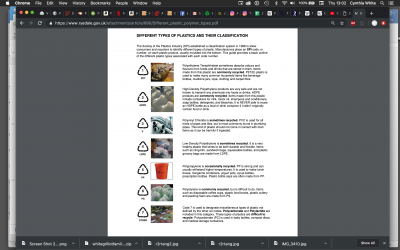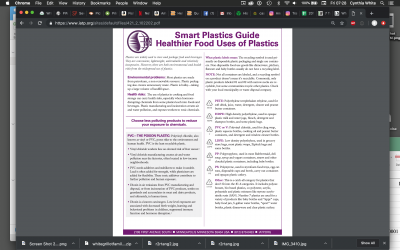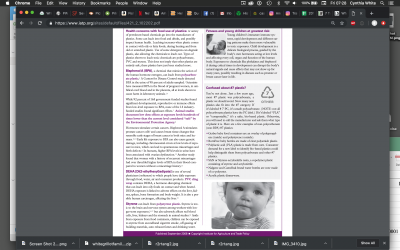Introduction
At the beginning of January, 2019, I wrote an article about glass. Shortly after that, I was asked to write an article about plastic. This is the result. The article below is organized in a similar way as the glass article.
Plastic is of interest to reef aquarists because we use it. Some people have acrylic tanks; plastic elbows are commonly put inside quarantine or hospital tanks; plastic pipes plumb saltwater systems; and there are lots of other common uses for plastic in and around your aquaria.
So, let’s start at the beginning.
What is plastic?
Plastic is by definition any material that is made of natural or synthetic or semi-synthetic polymers that can be made into different shapes without (easily) breaking. What these substances have in common is that they are A) made of polymers, B) made of carbon, and C) can change shape.
In modern language, the term “plasticity” has come to mean anything that can change shape or form easily.
What’s a polymer?
A polymer is a large molecule comprised of long chains of repeating units called monomers. There are naturally occurring polymers such as DNA or the keratin in your hair or the rubber from a rubber tree. Polymers are what make the material long and strong but malleable under certain conditions.
History of Plastic
Long before we had synthetic plastics, thousands of years ago, people discovered some natural plastics like chewing gum. Several different cultures discovered that some tree saps or resins had a “plastic” quality and could be chewed.
Even casein, which is the major protein extracted from milk, was used as a glue and fixative, and later as a plastic. Not all current plastics are synthetic. I, personally, have some excellent casein knitting needles.
Now I’ll cruise quickly through some plastics development in more modern history.
Credit for the first not-100%-natural plastic goes to Alexander Parkes in 1856, who in England combined cellulose and nitric acid and created what is considered the first thermoplastic, which he called Parkesine. A thermoplastic is a plastic that can be shaped or reshaped when it is heated to a certain temperature, and then it hardens when it cools.
In 1869, John Wesley Hyatt invented his own plastic concoction using cellulose and camphor. Both of these early plastics took pressure off of the ivory industry because these semi-artificial plastics could be molded into things like billiard balls or piano keys and replace ivory.
Leo Baekeland invented the first fully synthetic plastic in 1907. He called it Bakelite (or Baekelite), which anyone who watches the Antiques Roadshow will be familiar with because some of the things Bakelite was used for was antique radios, telephones, and jewelry, all of which can be quite valuable today.
Google results for "bakelite jewelry."

Screenshot courtesy of @Seawitch, ©2019, All Rights Reserved.
So, now we’ll fast forward to today.
What types of plastics are there?
There are tons of types of plastics: more than we even need to know about as far as aquariums go, but I’ll mention a few.
Bio-based plastics
Biodegradable plastics
Engineering plastics
Epoxy resins
Expanded polystyrene
Fluoropolymers
Polyolefins
Polystyrene
Polyurethanes
Polyvinyl chloride (PVC)
Thermoplastics are defined as those plastics that can be reheated and reshaped and cooled ad infinitum, such as polypropylene, polyvinyl chloride PVC, polystyrene, and polycarbonate.
Examples of Thermoplastics (1)
Acrylonitrile butadiene styrene (ABS)
Polycarbonate (PC)
Polyethylene (PE)
Polyethylene terephthalate (PET)
Polyvinyl chloride (PVC)
Polymethyl methacrylate (PMMA)
Polypropylene (PP)
Polystyrene (PS)
Expanded Polystyrene (EPS)
Thermoset plastics will not soften again once they have been hardened.
Examples of Thermoset Plastics
Epoxide (EP)
Phenol-formaldehyde (PF)
Polyurethane (PUR)
Polytetrafluoroethylene (PTFE)
Unsaturated polyester resins (UP)
So, the next question is, “is it okay to use plastic with saltwater?” And, the answer is yes, and reef aquarists have all been doing it for years. I specifically asked this question in the Reef2Reef Chemistry subforum, and Dr. Randy Holmes-Farley, said, yes, most types of plastic are okay—that is they won’t dissolve or leach undesirable things in saltwater.

Screenshot courtesy of @Seawitch, ©2019, All Rights Reserved.
And, in fact, many aquarists have aquaria made of acrylic. The advantages of acrylic are that it is much lighter than glass of the same thickness, acrylic is more resistant to chipping, is arguably easier to drill, and has much better impact resistance than float glass. The disadvantages of an acrylic tank are mainly that it scratches much more easily.
Then I wondered, should aquarists be making tanks out of polycarbonate? And the answer is a big N-O, NO. If you look at my little table below, you’ll see that polycarbonate scratches even more easily than acrylic, and polycarbonate is two or three times the price of acrylic. So, unless you were starting with polycarbonate that you got for free, I can’t see buying it to use instead of acrylic.

Table courtesy of @Seawitch, ©2019, All Rights Reserved.
It is possible to buy polycarbonate that is coated with something on one or both sides to resist scratching, but I found it very difficult to get hard information about what the coating is. One plastic company said that the coating would not dissolve in saltwater, but 12 other plastic companies said the coating was proprietary information, and they could tell me nothing.
I did acquire a Material Safety Data Sheet on one brand of scratch-resistant coating, which you will find below. Is that reef-safe? I don’t know. Probably. These coatings cure into a resin, and typically resins like a 2-part epoxy are reef-safe after they are cured and all the bad things have offgassed.

So, the next questions we want to ask and answer are A) what kinds of plastics are safe to use with a reef aquarium and B) are there any risks we haven't considered? And these are the questions that I will address in Part 2. Tomorrow. Or the next day. HAPPY EASTER, EVERYONE.
REFERENCES:
(1) https://www.plasticseurope.org/en/about-plastics/what-are-plastics/how-plastics-are-made
(2) https://www.plasticseurope.org/en/about-plastics/what-are-plastics/large-family
(3) https://en.wikipedia.org/wiki/Plastic
(4) https://www.acplasticsinc.com/informationcenter/r/acrylic-vs-polycarbonate
(5) https://www.interdynesystems.com/pdf/acrylic_vs_polycarbonate.pdf
(6) https://www.saint-gobain-sekurit.com/glossary/glass-properties
(7) https://www.bbc.com/news/magazine-27442625
(8) https://www.sciencehistory.org/the-history-and-future-of-plastics
(9) http://plastiquarian.com/?page_id=14228
(10) https://www.iatp.org/sites/default/files/421_2_102202.pdf
(11) https://www.livestrong.com/article/158674-which-plastic-containers-can-i-safely-use/
(12) https://www.ecowatch.com/7-types-of-plastic-wreaking-havoc-on-our-health-1882198584.html
(13) https://www.ncbi.nlm.nih.gov/pubmed/17707454
(14) http://petresin.org/science_behindpet.asp
(15) https://www.sciencedaily.com/releases/2008/06/080602091241.htm
(16) https://www.ewg.org/enviroblog/2017...archers-wary-plastic-pipes-leaching-chemicals
(17) https://www.ncbi.nlm.nih.gov/pubmed/21420710
(18) https://esemag.com/wp-content/uploads/2018/06/Pizzurro-et-al_2018_Piping-Review-White-Paper.pdf
~~~~~~~~~~~~
We encourage all our readers to join the Reef2Reef forum. It’s easy to register, free, and reefkeeping is much easier and more fun in a community of fellow aquarists. We pride ourselves on a warm and family-friendly forum where everyone is welcome. You will also find lots of contests and giveaways with our sponsors.
~~~~~~~~~~~~~
Author Profile: Cynthia White
Cynthia received her BA in English from NYU a long long time ago. She has been a freelance writer and editor for over 20 years. In 2018, she won the President's Award from the Professional Writers Association of Canada. Now she is a writer and editor on staff at R2R, where her forum nickname is @Seawitch. She lives on Vancouver Island with her husband, three special-needs dogs, and three saltwater aquariums being set up.
At the beginning of January, 2019, I wrote an article about glass. Shortly after that, I was asked to write an article about plastic. This is the result. The article below is organized in a similar way as the glass article.
Plastic is of interest to reef aquarists because we use it. Some people have acrylic tanks; plastic elbows are commonly put inside quarantine or hospital tanks; plastic pipes plumb saltwater systems; and there are lots of other common uses for plastic in and around your aquaria.
An acrylic see-through door to the sump.

Photo is from the Reef2Reef archives, courtesy of @WDKegge, ©2019, All Rights Reserved.
When I started this article, I had a bias. My husband, who I mentioned in the glass article because he had an architectural glass business for many years, suggested that I spend plenty of time researching polycarbonate because he thought aquarists might find it useful. So, my bias was that polycarbonate is this unappreciated gem available to aquarists. After much research, I have laid that bias to rest. If you get to the end of the article, you’ll find that I don’t recommend polycarbonate at all.Photo is from the Reef2Reef archives, courtesy of @WDKegge, ©2019, All Rights Reserved.
So, let’s start at the beginning.
What is plastic?
Plastic is by definition any material that is made of natural or synthetic or semi-synthetic polymers that can be made into different shapes without (easily) breaking. What these substances have in common is that they are A) made of polymers, B) made of carbon, and C) can change shape.
In modern language, the term “plasticity” has come to mean anything that can change shape or form easily.
What’s a polymer?
A polymer is a large molecule comprised of long chains of repeating units called monomers. There are naturally occurring polymers such as DNA or the keratin in your hair or the rubber from a rubber tree. Polymers are what make the material long and strong but malleable under certain conditions.
History of Plastic
Long before we had synthetic plastics, thousands of years ago, people discovered some natural plastics like chewing gum. Several different cultures discovered that some tree saps or resins had a “plastic” quality and could be chewed.
Even casein, which is the major protein extracted from milk, was used as a glue and fixative, and later as a plastic. Not all current plastics are synthetic. I, personally, have some excellent casein knitting needles.
Now I’ll cruise quickly through some plastics development in more modern history.
Credit for the first not-100%-natural plastic goes to Alexander Parkes in 1856, who in England combined cellulose and nitric acid and created what is considered the first thermoplastic, which he called Parkesine. A thermoplastic is a plastic that can be shaped or reshaped when it is heated to a certain temperature, and then it hardens when it cools.
In 1869, John Wesley Hyatt invented his own plastic concoction using cellulose and camphor. Both of these early plastics took pressure off of the ivory industry because these semi-artificial plastics could be molded into things like billiard balls or piano keys and replace ivory.
Leo Baekeland invented the first fully synthetic plastic in 1907. He called it Bakelite (or Baekelite), which anyone who watches the Antiques Roadshow will be familiar with because some of the things Bakelite was used for was antique radios, telephones, and jewelry, all of which can be quite valuable today.
Google results for "bakelite jewelry."
Screenshot courtesy of @Seawitch, ©2019, All Rights Reserved.
So, now we’ll fast forward to today.
What types of plastics are there?
There are tons of types of plastics: more than we even need to know about as far as aquariums go, but I’ll mention a few.
Bio-based plastics
Biodegradable plastics
Engineering plastics
Epoxy resins
Expanded polystyrene
Fluoropolymers
Polyolefins
Polystyrene
Polyurethanes
Polyvinyl chloride (PVC)
Thermoplastics are defined as those plastics that can be reheated and reshaped and cooled ad infinitum, such as polypropylene, polyvinyl chloride PVC, polystyrene, and polycarbonate.
Examples of Thermoplastics (1)
Acrylonitrile butadiene styrene (ABS)
Polycarbonate (PC)
Polyethylene (PE)
Polyethylene terephthalate (PET)
Polyvinyl chloride (PVC)
Polymethyl methacrylate (PMMA)
Polypropylene (PP)
Polystyrene (PS)
Expanded Polystyrene (EPS)
Thermoset plastics will not soften again once they have been hardened.
Examples of Thermoset Plastics
Epoxide (EP)
Phenol-formaldehyde (PF)
Polyurethane (PUR)
Polytetrafluoroethylene (PTFE)
Unsaturated polyester resins (UP)
So, the next question is, “is it okay to use plastic with saltwater?” And, the answer is yes, and reef aquarists have all been doing it for years. I specifically asked this question in the Reef2Reef Chemistry subforum, and Dr. Randy Holmes-Farley, said, yes, most types of plastic are okay—that is they won’t dissolve or leach undesirable things in saltwater.
Screenshot courtesy of @Seawitch, ©2019, All Rights Reserved.
And, in fact, many aquarists have aquaria made of acrylic. The advantages of acrylic are that it is much lighter than glass of the same thickness, acrylic is more resistant to chipping, is arguably easier to drill, and has much better impact resistance than float glass. The disadvantages of an acrylic tank are mainly that it scratches much more easily.
Then I wondered, should aquarists be making tanks out of polycarbonate? And the answer is a big N-O, NO. If you look at my little table below, you’ll see that polycarbonate scratches even more easily than acrylic, and polycarbonate is two or three times the price of acrylic. So, unless you were starting with polycarbonate that you got for free, I can’t see buying it to use instead of acrylic.
Table courtesy of @Seawitch, ©2019, All Rights Reserved.
It is possible to buy polycarbonate that is coated with something on one or both sides to resist scratching, but I found it very difficult to get hard information about what the coating is. One plastic company said that the coating would not dissolve in saltwater, but 12 other plastic companies said the coating was proprietary information, and they could tell me nothing.
I did acquire a Material Safety Data Sheet on one brand of scratch-resistant coating, which you will find below. Is that reef-safe? I don’t know. Probably. These coatings cure into a resin, and typically resins like a 2-part epoxy are reef-safe after they are cured and all the bad things have offgassed.
So, the next questions we want to ask and answer are A) what kinds of plastics are safe to use with a reef aquarium and B) are there any risks we haven't considered? And these are the questions that I will address in Part 2. Tomorrow. Or the next day. HAPPY EASTER, EVERYONE.
REFERENCES:
(1) https://www.plasticseurope.org/en/about-plastics/what-are-plastics/how-plastics-are-made
(2) https://www.plasticseurope.org/en/about-plastics/what-are-plastics/large-family
(3) https://en.wikipedia.org/wiki/Plastic
(4) https://www.acplasticsinc.com/informationcenter/r/acrylic-vs-polycarbonate
(5) https://www.interdynesystems.com/pdf/acrylic_vs_polycarbonate.pdf
(6) https://www.saint-gobain-sekurit.com/glossary/glass-properties
(7) https://www.bbc.com/news/magazine-27442625
(8) https://www.sciencehistory.org/the-history-and-future-of-plastics
(9) http://plastiquarian.com/?page_id=14228
(10) https://www.iatp.org/sites/default/files/421_2_102202.pdf
(11) https://www.livestrong.com/article/158674-which-plastic-containers-can-i-safely-use/
(12) https://www.ecowatch.com/7-types-of-plastic-wreaking-havoc-on-our-health-1882198584.html
(13) https://www.ncbi.nlm.nih.gov/pubmed/17707454
(14) http://petresin.org/science_behindpet.asp
(15) https://www.sciencedaily.com/releases/2008/06/080602091241.htm
(16) https://www.ewg.org/enviroblog/2017...archers-wary-plastic-pipes-leaching-chemicals
(17) https://www.ncbi.nlm.nih.gov/pubmed/21420710
(18) https://esemag.com/wp-content/uploads/2018/06/Pizzurro-et-al_2018_Piping-Review-White-Paper.pdf
~~~~~~~~~~~~
We encourage all our readers to join the Reef2Reef forum. It’s easy to register, free, and reefkeeping is much easier and more fun in a community of fellow aquarists. We pride ourselves on a warm and family-friendly forum where everyone is welcome. You will also find lots of contests and giveaways with our sponsors.
~~~~~~~~~~~~~
Author Profile: Cynthia White
Cynthia received her BA in English from NYU a long long time ago. She has been a freelance writer and editor for over 20 years. In 2018, she won the President's Award from the Professional Writers Association of Canada. Now she is a writer and editor on staff at R2R, where her forum nickname is @Seawitch. She lives on Vancouver Island with her husband, three special-needs dogs, and three saltwater aquariums being set up.


















